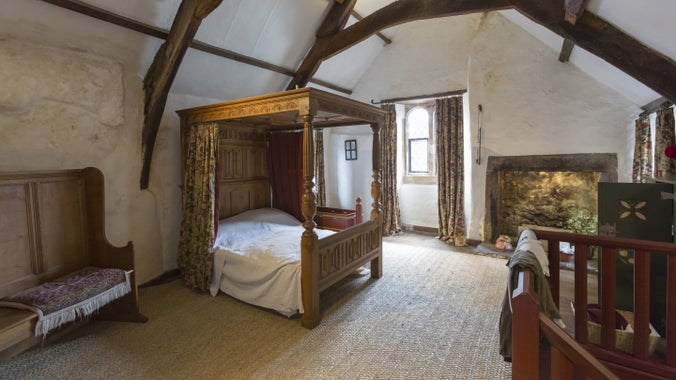
Tudor Merchant's House collections
Explore the objects and works of art we care for at Tudor Merchant's House on the National Trust Collections website.

This narrow house is typical of the type of prosperous merchant’s house that sprang up when Tenby was a thriving port in the late Middle Ages. Discover how most of the merchant’s produce was imported from overseas or came through the coastal trade routes around Britain.
During Tudor times, Tenby was a hub for overseas trade, importing a wide variety of stock for sale. Find out more about the items you may have been able to buy if you’d visited this busy merchant’s house in Tenby.
Salt was a vital part of Tudor daily life, used not only as a table condiment but also for salting or preserving meat and fish.
The salt brought into Tenby was called ‘bay salt'. This salt came from shores of the Bay of Biscay and Portugal. Salt is still produced in the same way today by evaporating salt water in shallow pools or salt pans in full sun.
Linen was a common fabric in daily use. Linen is made from the fibres of the flax plant. Although it was produced in Britain and Ireland, the best linen came from France. This cloth is extremely hard wearing and can easily be dyed or coloured.

In Tudor times, painted or ‘stained’ cloths were a popular substitute for tapestries. They were cheaper to produce by painting or staining linen cloth. They were much lighter in weight which made them easier to hang from plaster walls.
Most wine imported into Britain in Tudor times came from Gascony in southern France. It was imported in large barrels or 'tuns', with iron hoops for strength. A replica can be seen in the Tudor merchant’s shop.
A tun of Gascon wine cost about £3, about the annual income of a maid servant. A knight might have an annual income of around £40. Vinegar was also imported to Tenby from Brittany in northern France
Sugar was an expensive luxury and came from the Canary Islands in Portuguese ships. A chest of sugar was valued at around £8.
Imports from Ireland included herrings, flax and lower-grade wool and cloth. Tallow, made from animal fat, had many uses, and was often made into candles and soap.
There were exports going out from Tenby too. Coarse woollen cloth suitable for winter clothing and for mariners to wear was a common item traded.
During Tudor times the coal trade was only just beginning but Tenby was already exporting anthracite to Ireland. A 'Culm ball' was made of anthracite dust mixed with clay. This which burned more slowly and were very popular in Ireland.

Explore the objects and works of art we care for at Tudor Merchant's House on the National Trust Collections website.
Discover the home of a prosperous Tudor trader at the Tudor Merchant’s house. Find out what Tudor life was like for a popular trader of the Middle Ages at this special place.
